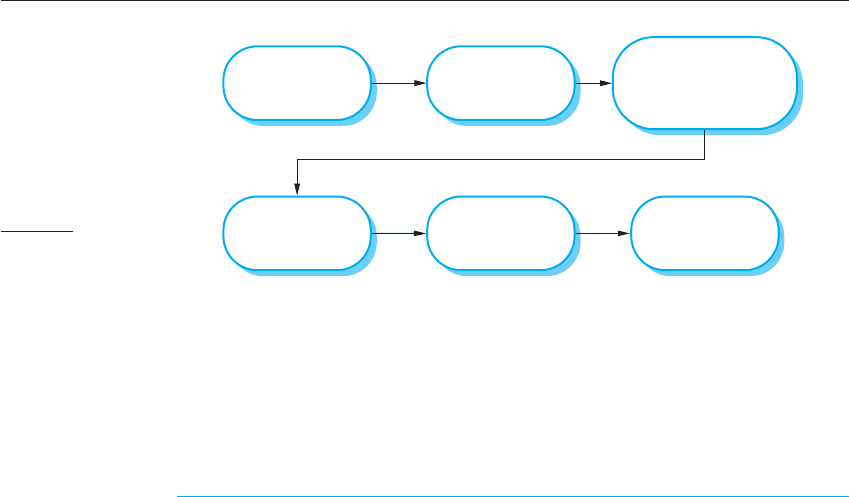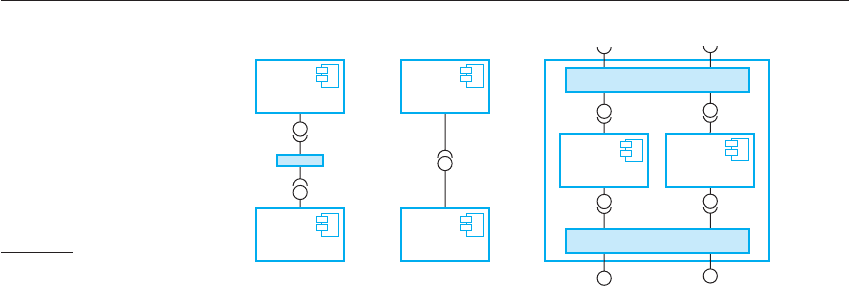Sommerville I. Software Engineering (9th edition)
Подождите немного. Документ загружается.


464 Chapter 17 ■ Component-based software engineering
Mili et al. (2002) discuss ways of estimating the costs of making a component
reusable and the returns from that investment. The benefits of reusing rather than
redeveloping a component are not simply productivity gains. There are also quality
gains, because a reused component should be more dependable, and time-to-market
gains. These are the increased returns that accrue from deploying the software more
quickly. Mili et al. present various formulas for estimating these gains, as does
the COCOMO model discussed in Chapter 23 (Boehm, et al., 2000). However, the
parameters of these formulas are difficult to estimate accurately, and the formulas
must be adapted to local circumstances, making them difficult to use. I suspect that
few software project managers use these models to estimate the return on investment
from component reusability.
Obviously, whether or not a component is reusable depends on its application
domain and functionality. As you add generality to a component, you increase its
reusability. However, this normally means that the component has more operations
and is more complex, which makes the component harder to understand and use.
There is, therefore, an inevitable trade-off between reusability and usability of a
component. To make a component reusable you have to provide a set of generic
interfaces with operations that cater to all of the ways in which the component could
be used. Making the component usable means providing a simple, minimal interface
that is easy to understand. Reusability adds complexity and hence reduces compo-
nent understandability. It is therefore more difficult to decide when and how to reuse
that component. When designing a reusable component, you must, therefore, find a
compromise between generality and understandability.
A potential source of components is existing legacy systems. As I discussed in
Chapter 9, these are systems that fulfill an important business function but are writ-
ten using obsolete software technologies. Because of this, it may be difficult to use
them with new systems. However, if you convert these old systems to components,
their functionality can be reused in new applications.
Of course, these legacy systems do not normally have clearly defined ‘requires’
and ‘provides’ interfaces. To make these components reusable, you have to create a
wrapper that defines the component interfaces. The wrapper hides the complexity of
the underlying code and provides an interface for external components to access serv-
ices that are provided. Although this wrapper is a fairly complex piece of software,
the cost of wrapper development is often much less than the cost of reimplementing
the legacy system. I discuss this approach in more detail in Chapter 19, where
I explain how the features in a legacy system can be accessed through services.
Once you have developed and tested a reusable component or service, this then
has to be managed for future reuse. Management involves deciding how to classify
the component so that it can be discovered, making the component available either in
a repository or as a service, maintaining information about the use of the component
and keeping track of different component versions. If the component is open source,
you may make it available in a public repository such as Sourceforge. If it is intended
for use in a company, then you may use an internal repository system.
A company with a reuse program may carry out some form of component certifi-
cation before the component is made available for reuse. Certification means that

17.2 ■ CBSE processes 465
someone apart from the developer checks the quality of the component. They test the
component and certify that it has reached an acceptable quality standard, before it is
made available for reuse. However, this can be an expensive process and many com-
panies simply leave testing and quality checking to the component developers.
17.2.2 CBSE with reuse
The successful reuse of components requires a development process tailored to
CBSE. The CBSE with reuse process has to include activities that find and integrate
reusable components. The structure of such a process was discussed in Chapter 2
and Figure 17.7 shows the principal activities within that process. Some of the
activities within this process, such as the initial discovery of user requirements, are
carried out in the same way as in other software processes. However, the essential
differences between CBSE with reuse and software processes for original software
development are:
1. The user requirements are initially developed in outline rather than in detail, and
stakeholders are encouraged to be as flexible as possible in defining their
requirements. Requirements that are too specific limit the number of compo-
nents that could meet these requirements. However, unlike incremental develop-
ment, you need a complete set of requirements so that you can identify as many
components as possible for reuse.
2. Requirements are refined and modified early in the process depending on the
components available. If the user requirements cannot be satisfied from avail-
able components, you should discuss the related requirements that can be sup-
ported. Users may be willing to change their minds if this means cheaper or
quicker system delivery.
3. There is a further component search and design refinement activity after the sys-
tem architecture has been designed. Some apparently usable components may
turn out to be unsuitable or do not work properly with other chosen components.
Although not shown in Figure 17.7, this implies that further requirements
changes may be necessary.
Identify Candidate
Components
Outline
System
Requirements
Modify
Requirements
According to Discovered
Components
Architectural
Design
Compose
Components to
Create System
Identify Candidate
Components
Figure 17.7 CBSE with
reuse

466 Chapter 17 ■ Component-based software engineering
4. Development is a composition process where the discovered components are
integrated. This involves integrating the components with the component model
infrastructure and, often, developing adaptors that reconcile the interfaces
of incompatible components. Of course, additional functionality may also be
required over and above that provided by reused components.
The architectural design stage is particularly important. Jacobson et al. (1997)
found that defining a robust architecture is critical for successful reuse. During the
architectural design activity, you may choose a component model and implementa-
tion platform. However, many companies have a standard development platform
(e.g., .NET) so the component model is pre-determined. As I discussed in Chapter 6,
you also establish the high-level organization of the system at this stage and make
decisions about system distribution and control.
An activity that is unique to the CBSE process is identifying candidate compo-
nents or services for reuse. This involves a number of subactivities, as shown in
Figure 17.8. Initially, your focus should be on search and selection. You need to con-
vince yourself that there are components available to meet your requirements.
Obviously, you should do some initial checking that the component is suitable but
detailed testing may not be required. In the later stage, after the system architecture
has been designed, you should spend more time on component validation. You need
to be confident that the identified components are really suited to your application; if
not, then you have to repeat the search and selection processes.
The first step in identifying components is to look for components that are avail-
able locally or from trusted suppliers. As I said in the previous section, there are rel-
atively few component vendors so you are therefore most likely to be looking for
components that have been developed in your own company. Software development
companies can build their own database of reusable components without the risks
inherent in using components from external suppliers. Alternatively, you may decide
to search code libraries available on the Web, such as Sourceforge or Google Code,
to see if source code for the component that you need is available. If you are looking
for services, then there are a number of specialized web search engines available that
can discover public web services.
Once the component search process has identified possible components, you have
to select candidate components for assessment. In some cases, this will be a straight-
forward task. Components on the list will directly implement the user requirements
and there will not be competing components that match these requirements. In other
cases, however, the selection process is much more complex. There will not be a clear
mapping of requirements onto components and you may find that several components
have to be integrated to meet a specific requirement or group of requirements.
Component
Validation
Component
Selection
Component
Search
Figure 17.8 The
component
identification
process

17.2 ■ CBSE processes 467
You, therefore, have to decide which component compositions provide the best cover-
age of the requirements.
Once you have selected components for possible inclusion in a system, you
should then validate them to check that they behave as advertised. The extent of the
validation required depends on the source of the components. If you are using a
component that has been developed by a known and trusted source, you may decide
that component testing is unnecessary. You simply test the component when it is
integrated with other components. On the other hand, if you are using a component
from an unknown source, you should always check and test that component before
including it in your system.
Component validation involves developing a set of test cases for a component (or,
possibly, extending test cases supplied with that component) and developing a test
harness to run component tests. The major problem with component validation is
that the component specification may not be sufficiently detailed to allow you to
develop a complete set of component tests. Components are usually specified infor-
mally, with the only formal documentation being their interface specification. This
may not include enough information for you to develop a complete set of tests that
would convince you that the component’s advertised interface is what you require.
As well as testing that a component for reuse does what you require, you may also
have to check that the component does not include any malicious code or functional-
ity that you don’t need. Professional developers rarely use components from
untrusted sources, especially if these sources do not provide source code. Therefore,
the malicious code problem does not usually arise. However, components may often
contain functionality that you don’t need and you have to check that this functional-
ity will not interfere with your use of the component.
The problem with unnecessary functionality is that it may be activated by the
component itself. This can slow down the component, cause it to produce surprising
results or, in some cases, cause serious system failures. Figure 17.9 summarizes a sit-
uation where unnecessary functionality in a reused system caused a catastrophic
software failure.
Figure 17.9 An
example of validation
failure with reused
software
The Ariane 5 launcher Failure
While developing the Ariane 5 space launcher, the designers decided to reuse the inertial reference software
that had performed successfully in the Ariane 4 launcher. The inertial reference software maintains the stability
of the rocket. They decided to reuse this without change (as you would do with components), although it
included additional functionality that was not required in Ariane 5.
In the first launch of Ariane 5, the inertial navigation software failed and the rocket could not be controlled.
Ground controllers instructed the launcher to self-destruct and the rocket and its payload were destroyed. The
cause of the problem was an unhandled exception when a conversion of a fixed-point number to an integer
resulted in a numeric overflow. This caused the run-time system to shut down the inertial reference system and
launcher stability could not be maintained. The fault had never occurred in Ariane 4 because it had less
powerful engines and the value that was converted could not be large enough for the conversion to overflow.
The fault occurred in code that was not required for Ariane 5. The validation tests for the reused software were
based on Ariane 5 requirements. Because there were no requirements for the function that failed, no tests were
developed. Consequently, the problem with the software was never discovered during launch simulation tests.

468 Chapter 17 ■ Component-based software engineering
The problem in the Ariane 5 launcher arose because the assumptions made about
the software for Ariane 4 were invalid for Ariane 5. This is a general problem with
reusable components. They are originally implemented for an application environ-
ment and, naturally, embed assumptions about that environment. These assumptions
are rarely documented so, when the component is reused, it is impossible to derive
tests to check if the assumptions are still valid. If you are reusing a component in a
different environment, you may not discover the embedded environmental assump-
tions until you use the component in an operational system.
17.3
Component composition
Component composition is the process of integrating components with each other, and
with specially written ‘glue code’ to create a system or another component. There are
several different ways in which you can compose components, as shown in Figure 17.10.
From left to right these diagrams illustrate sequential composition, hierarchical composi-
tion and additive composition. In the discussion below, I assume that you are composing
two components (A and B) to create a new component:
1. Sequential composition is situation (a) in Figure 17.10. You create a new compo-
nent from 2 existing components by calling the existing components in sequence.
You can think of the composition as a composition of the ‘provides interfaces’.
That is, the services offered by component A are called and the results returned
by A are then used in the call to the services offered by component B. The com-
ponents do not call each other in sequential composition. Some extra glue code is
required to call the component services in the right order and to ensure that the
results delivered by component A are compatible with the inputs expected by
component B. The ‘provides’ interface of the composition depends on the com-
bined functionality of A and B but will not normally be a composition of their
‘provides interfaces’. This type of composition may be used with components
that are program elements or components that are services.
2. Hierarchical composition is situation (b) in Figure 17.10. This type of composi-
tion occurs when one component calls directly on the services provided by
another component. The called component provides the services that are required
by the calling component. Therefore, the ‘provides’ interface of the called compo-
nent must be compatible with the ‘requires’ interface of the calling component.
Component A calls on component B directly and, if their interfaces match, there
may be no need for additional code. However, if there is a mismatch between the
‘requires’ interface of A and the ‘provides’ interface of B, then some conversion
code may be required. As services do not have a ‘requires’ interface, this mode of
composition is not used when components are implemented as web services.
3. Additive composition corresponds to situation (c) in Figure 17.10. This occurs
when two or more components are put together (added) to create a new component,

17.3 ■ Component composition 469
which combines their functionality. The ‘provides’ interface and ‘requires’ inter-
face of the new component is a combination of the corresponding interfaces in
components A and B. The components are called separately through the external
interface of the composed component. A and B are not dependent and do not call
each other. This type of composition may be used with components that are pro-
gram units or components that are services.
You might use all the forms of component composition when creating a system.
In all cases, you may have to write ‘glue code’ that links the components. For exam-
ple, for sequential composition, the output of component A typically becomes the
input to component B. You need intermediate statements that call component A, col-
lect the result, and then call component B with that result as a parameter. When one
component calls another, you may need to introduce an intermediate component that
ensures that the ‘provides’ interface and the ‘requires’ interface are compatible.
When you write new components especially for composition, you should design the
interfaces of these components so that they are compatible with other components in the
system. You can therefore easily compose these components into a single unit.
However, when components are developed independently for reuse, you will often be
faced with interface incompatibilities. This means that the interfaces of the components
that you wish to compose are not the same. Three types of incompatibility can occur:
1. Parameter incompatibility The operations on each side of the interface have the
same name but their parameter types or the number of parameters are different.
2. Operation incompatibility The names of the operations in the ‘provides’ and
‘requires’ interfaces are different.
3. Operation incompleteness The ‘provides’ interface of a component is a subset
of the ‘requires’ interface of another component or vice versa.
In all cases, you tackle the problem of incompatibility by writing an adaptor that
reconciles the interfaces of the two components being reused. An adaptor component
converts one interface to another. The precise form of the adaptor depends on the type
(a)
A A
BB
(b)
(c)
A
B
Figure 17.10 Types of
component composition

470 Chapter 17 ■ Component-based software engineering
of composition. Sometimes, as in the next example, the adaptor takes a result from one
component and converts it into a form where it can be used as an input to another. In
other cases, the adaptor may be called by component A as a proxy for component B.
This situation occurs if A wishes to call B but the details of the ‘requires’ interface of
A do not match the details of the ‘provides’ interface of B. The adaptor reconciles
these differences by converting its input parameters from A into the required input
parameters for B. It then calls B to deliver the services required by A.
To illustrate adaptors, consider the two components shown in Figure 17.11,
whose interfaces are incompatible. These might be part of a system used by the
emergency services. When the emergency operator takes a call, the phone number
is input to the addressFinder component to locate the address. Then, using the
mapper component, the operator prints a map to be sent to the vehicle dispatched
to the emergency. In fact, the components would have more complex interfaces
than those shown here, but the simplified version illustrates the concept of an
adaptor.
The first component, addressFinder, finds the address that matches a phone num-
ber. It can also return the owner of the property associated with the phone number and
the type of property. The mapper component takes a post code (in the United States,
a standard ZIP code with the additional four digits identifying property location) and
displays or prints a street map of the area around that code at a specified scale.
These components are composable in principle because the property location
includes the post or ZIP code. However, you have to write an adaptor component
called postCodeStripper that takes the location data from addressFinder and
strips out the post code. This post code is then used as an input to mapper and the
street map is displayed at a scale of 1:10,000. The following code, which is an
example of sequential composition, illustrates the sequence of calls that is required
to implement this:
address = addressFinder.location (phonenumber) ;
postCode = postCodeStripper.getPostCode (address) ;
mapper.displayMap(postCode, 10000) ;
phoneDatabase (string command)
string location (string pn)
string owner (string pn)
string propertyType (string pn)
mapDB (string command)
displayMap (string postCode, scale)
printMap (string postCode, scale)
addressFinder
mapper
Figure 17.11
Components with
incompatible interfaces

17.3 ■ Component composition 471
Another case in which an adaptor component may be used is in hierarchical com-
position, where one component wishes to make use of another but there is an incom-
patibility between the ‘provides’ interface and ‘requires’ interface of the components
in the composition. I have illustrated the use of an adaptor in Figure 17.12 where an
adaptor is used to link a data collector and a sensor component. These could be used
in the implementation of a wilderness weather station system, as discussed in
Chapter 7.
The sensor and data collector components are composed using an adapter that
reconciles the ‘requires’ interface of the data collection component with the
‘provides’ interface of the sensor component. The data collector component has
been designed with a generic ‘requires’ interface that supports sensor data
collection and sensor management. For each of these operations, the parameter
is a text string representing the specific sensor commands. For example, to issue
a collect command, you would say sensorData(“collect”). As I have shown in
Figure 17.12, the sensor itself has separate operations such as start, stop, and
getdata.
The adaptor parses the input string, identifies the command (e.g., collect) and
then calls Sensor.getdata to collect the sensor value. It then returns the result (as a
character string) to the data collector component. This interface style means that the
data collector can interact with different types of sensor. A separate adaptor, which
converts the sensor commands from Data collector to the actual sensor interface, is
implemented for each type of sensor.
The above discussion of component composition assumes you can tell from
the component documentation whether or not interfaces are compatible. Of
course, the interface definition includes the operation name and parameter types,
so you can make some assessment of the compatibility from this. However, you
depend on the component documentation to decide whether the interfaces are
semantically compatible.
To illustrate this problem, consider the composition shown in Figure 17.13. These
components are used to implement a system that downloads images from a digital
camera and stores them in a photograph library. The system user can provide
additional information to describe and catalog the photograph. To avoid clutter,
addSensor
removeSensor
startSensor
stopSensor
testSensor
listAll
report
initialize
sensorManagement
sensorData
AdapterSensor
start
getdata
stop
Data Collector
Figure 17.12 An
adaptor linking a data
collector and a sensor

472 Chapter 17 ■ Component-based software engineering
Photo
Library
Adaptor
Image
Manager
getImage
User
Interface
getCatalogEntry
addItem
retrieve
catEntry
Figure 17.13 Photo
library composition
I have not shown all interface methods here. Rather, I simply show the methods that
are needed to illustrate the component documentation problem. The methods in the
interface of Photo Library are:
public void addItem (Identifier pid ; Photograph p; CatalogEntry
photodesc) ;
public Photograph retrieve (Identifier pid) ;
public CatalogEntry catEntry (Identifier pid);
Assume that the documentation for the addItem method in Photo Library is:
This method adds a photograph to the library and associates the photograph
identifier and catalogue descriptor with the photograph.
This description appears to explain what the component does, but consider the
following questions:
• What happens if the photograph identifier is already associated with a photograph
in the library?
• Is the photograph descriptor associated with the catalog entry as well as the pho-
tograph? That is, if you delete the photograph, do you also delete the catalog
information?
There is not enough information in the informal description of addItem to answer
these questions. Of course, it is possible to add more information to the natural lan-
guage description of the method, but in general, the best way to resolve ambiguities
is to use a formal language to describe the interface. The specification shown in
Figure 17.14 is part of the description of the interface of Photo Library that adds
information to the informal description.
The specification in Figure 17.14 uses pre- and post-conditions that are defined in
a notation based on the object constraint language (OCL), which is part of the UML
(Warmer and Kleppe, 2003). OCL is designed to describe constraints in UML object
models; it allows you to express predicates that must always be true, that must be

17.3 ■ Component composition 473
true before a method has executed; and that must be true after a method has exe-
cuted. These are invariants, pre-conditions, and post-conditions. To access the value
of a variable before an operation, you add @pre after its name. Therefore, using age
as an example:
age = age@pre + 1
This statement means that the value of age after an operation is one more than it
was before that operation.
OCL-based approaches are increasingly used to add semantic information to UML
models, and OCL descriptions may be used to drive code generators in model-driven
engineering. The general approach has been derived from Meyer’s Design by
Contract approach (Meyer, 1992), in which the interfaces and obligations of commu-
nicating objects are formally specified and enforced by the run-time system. Meyer
suggests that using Design by Contract is essential if we are to develop trusted com-
ponents (Meyer, 2003).
Figure 17.14 includes a specification for the addItem and delete methods in
Photo Library. The method being specified is indicated by the keyword context and
the pre- and post-conditions by the keywords pre and post. The pre-conditions for
addItem state that:
1. There must not be a photograph in the library with the same identifier as the
photograph to be entered.
2. The library must exist—assume that creating a library adds a single item to it so
that the size of a library is always greater than zero.
Figure 17.14 The
OCL description
of the Photo Library
interface
— The context keyword names the component to which the conditions apply
context addItem
— The preconditions specify what must be true before execution of addItem
pre: PhotoLibrary.libSize() > 0
PhotoLibrary.retrieve(pid) = null
— The postconditions specify what is true after execution
post: libSize () = libSize()@pre + 1
PhotoLibrary.retrieve(pid) = p
PhotoLibrary.catEntry(pid) = photodesc
context delete
pre: PhotoLibrary.retrieve(pid) <>null ;
post: PhotoLibrary.retrieve(pid) = null
PhotoLibrary.catEntry(pid) = PhotoLibrary.catEntry(pid)@pre
PhotoLibrary.libSize() = libSize()@pre—1
